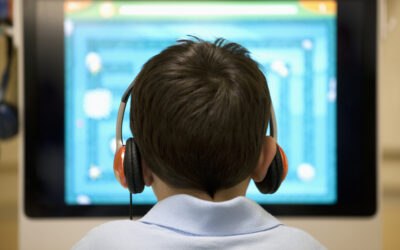Computational thinking has become important to teaching problem solving in education because it empowers students with processes to develop strategic solutions to complex problems, essentially “leveling up” their skills, or creating algorithms that can make future processes more effective. This enables students to take on more complex challenges and prepare for real-world applications.
Decomposition in Computational Thinking
While the process of computational thinking is multifaceted, there is one key to computational thinking that is essential for success: decomposition. Decomposition is the process of breaking a complex task or problem into smaller, more manageable pieces. From this decomposition, students can eliminate unnecessary information, identify patterns and begin the process of identifying which parts of the problem are most important, how to solve or complete each step, and how those parts can be put together for a clear and unified step-by-step solution.
Why is the Decomposition Technique Required in Computational Thinking?
The technique of decomposition is required in computational thinking because it breaks complex tasks into subtasks while developing a sequentially-based understanding of the problem. This allows unnecessary information to be discarded, patterns to be identified, relevant information to be extracted and the process of step-by-step resolution to be defined for a more effective problem-solving process.
By definition, computational thinking is the process of tackling complex problems and finding a clear, step-by-step solution that can be replicated. Decomposition, therefore, is essential to this process as it includes breaking a task into several sub-tasks, helping to align the task to a step-by-step solution.
Another reason decomposition in computational thinking is important is because it allows each subtask to be examined more closely. This not only helps to categorize information as essential or non-essential, but also empowers the problem-solver with a better ability to analyze each specific part of the task or challenge to more effectively develop a reasonable solution.
Examples of Decomposition in Computational Thinking
Below are some real-world examples of utilizing decomposition in computational thinking:
- You have to clean your house. Instead of facing the task as a whole, you practice decomposition by breaking the task into a to-do list with multiple subtasks.
- To build shelves for a storage space, you practice decomposition by measuring the space, creating a blueprint or plan to determine the size of the shelves and the materials you need to accomplish the task. Next, you purchase the supplies and cut the lumber to size, then install one wall of shelves at a time.
- In science, to prove or disprove a hypothesis, you practice decomposition by creating subtasks including background research, observation, generating a hypothesis, determining which variables to test, performing experiments and drawing a conclusion.
Final Thoughts
Consider how often computational thinking appears in your everyday life. Do you naturally use decomposition and computational thinking to resolve a challenge? For more information about computational thinking and how they apply to students, explore some of our most recent articles:
How to Talk to Kids About Being Safe Online
As the seasons transition and back to school takes off, my focus shifts to my child's safety, both physically and online, and how she is navigating this ever-changing digital landscape. Just as we previously collaborated on a safety plan for physical situations, I...
Back to School: Why More Schools Are Adding Computer Science this Year
Fall is one of my favorite times of the year. We begin to experience crisp, cool air in the mornings and evenings, and football is just around the corner! Also at this time of year, millions of students and teachers are returning to school across the country. In some...
How to Map the Scope & Sequence for Your Digital Literacy Curriculum
This article is an excerpt from our eBook, Building a Digital Literacy Program that Nurtures Future-Ready Students. To build a digital literacy program that is both equitable and effective, developing a comprehensive scope and sequence for the curriculum is...
AI… A Teacher’s Assistant
Artificial Intelligence, or AI, as we commonly refer to it, is the ability of machines to perform tasks that would normally require human intelligence, such as learning, problem solving, decision making, and language understanding. AI systems are designed to analyze...
Closing the Digital Divide with Digital Citizenship for Parents
In households that don't have a culture of computer use, it is often children who teach their parents how to accomplish various tasks on the internet. In fact, technology can create anxiety for parents when they feel that their children know much more than they do....
Digital Literacy Curriculum: What is it and why is it important?
Computer lab, typing class, technology workshop — while schools may call the classes by different names, digital literacy curriculum in some variation has been prominent in schools across the nation for several years. But what, exactly, is digital literacy curriculum...
Early Learning in Coding: Teaching Children Coding in Ages 3 and Up
Learning coding at an early age is becoming a priority for parents and educators alike. With research suggesting learning coding at young ages can improve mathematical conceptualization, problem-solving and social skills, the benefits of teaching children coding is...
McDowell County Schools Aim to Ensure Digital Equity
McDowell County Schools is a K-12 district in rural West Virginia. When Joey Norris, Coordinator of Technology Integration for MCS, grew up in the area, the community thrived on coal mining. But today, more than a quarter of the county’s 20,000 residents live in...
What is Digital Citizenship & What Does It Include?
You’ve probably heard “digital citizenship” being used in conjunction with digital literacy skills, but sometimes the definition can seem a little fuzzy. In this article, we discuss what digital citizenship means, the primary components of digital citizenship...
Five Proven Strategies for Educators to Support Digital Literacy
In a previous article on the importance of media literacy education, we defined digital literacy as the ability to read, analyze, construct and reconstruct ideas in the realm of online spaces. As we gradually transition into a more technologically integrated world,...
What Are Computer Fundamentals & Why Are They Important?
Computer fundamentals refers to the basics of using digital devices such as computers, smart phones and tablets. “Computer” used to only refer to the basics of using a computer and associated devices; however, it has since expanded to include most frequently-used...
In Texas, Big District Makes Big Difference in Digital Skills
Houston Independent School District is the 8th largest district in the U.S. and the largest in Texas. As technology became more thoroughly integrated into education in recent years, the district decided to raise awareness and increase implementation of Learning.com's...

Learning.com Team
Staff Writers
Founded in 1999, Learning.com provides educators with solutions to prepare their students with critical digital skills. Our web-based curriculum for grades K-12 engages students as they learn keyboarding, online safety, applied productivity tools, computational thinking, coding and more.
Further Reading
Digital Literacy in 2024: 7 Important Computer Skills for Future-Ready Students
In 2024, the technological landscape continues to evolve faster than ever. Innovations in artificial intelligence, cloud computing and cybersecurity...
Bridging Success: Crafting Your Professional Development Plan
It may seem premature to think about Back-to-School 2024 when we’re only in February. But at Learning.com, we’re always planning ahead. We’ve been...
The Importance of Digital Citizenship: A 2024 Perspective
Digital citizenship is an increasingly vital concept in our interconnected digital age. It encompasses the norms of appropriate and responsible...
















